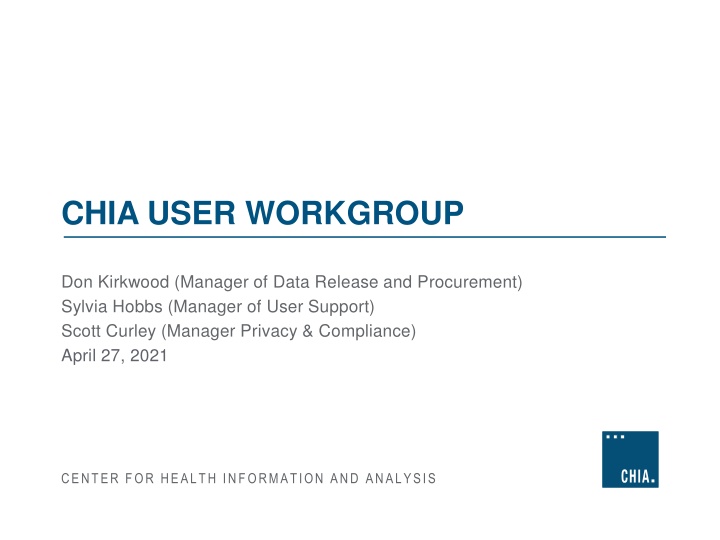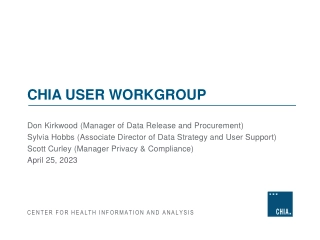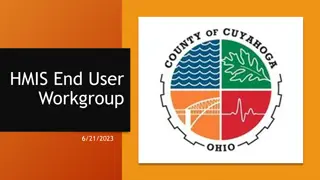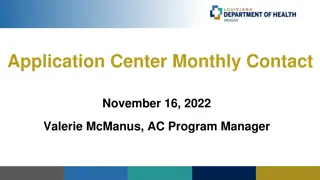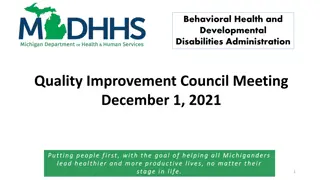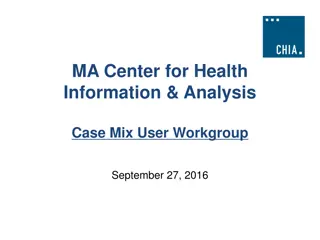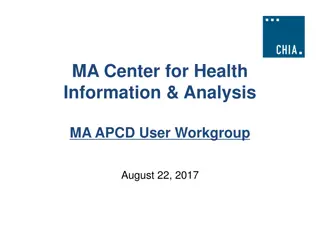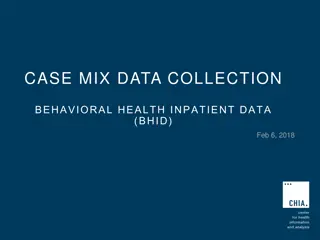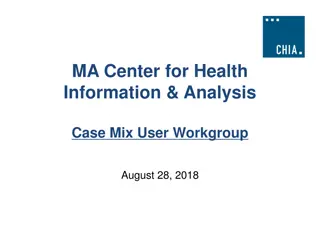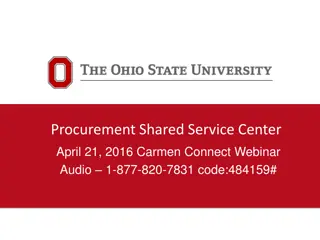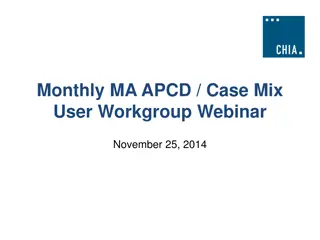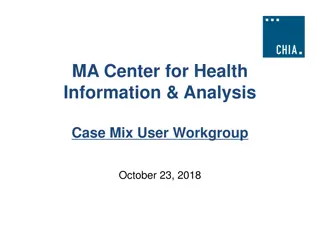CHIA Workgroup Updates - Data Release and Application Reminders
"Announcements and updates from the CHIA User Workgroup featuring recent releases, application reminders, and data availability. Stay informed about APCD Release 8.0, FY19 Case Mix projections, and important changes to data release processes during remote working conditions." (398 characters)
Download Presentation

Please find below an Image/Link to download the presentation.
The content on the website is provided AS IS for your information and personal use only. It may not be sold, licensed, or shared on other websites without obtaining consent from the author.If you encounter any issues during the download, it is possible that the publisher has removed the file from their server.
You are allowed to download the files provided on this website for personal or commercial use, subject to the condition that they are used lawfully. All files are the property of their respective owners.
The content on the website is provided AS IS for your information and personal use only. It may not be sold, licensed, or shared on other websites without obtaining consent from the author.
E N D
Presentation Transcript
CHIA USER WORKGROUP Don Kirkwood (Manager of Data Release and Procurement) Sylvia Hobbs (Manager of User Support) Scott Curley (Manager Privacy & Compliance) April 27, 2021 CENTER FOR HEALTH INFORMATION AND ANALYSIS
Agenda Announcements: APCD Release 8.0 Updates FY19 Case Mix Release Projections Data Release and Application Update Website Updates Application Reminders User Support Questions Emergency Department Data; Case Mix Financial Data; Hospital Inpatient Leave of Absence Days; Differences Between Case Mix Inpatient Volume and MA APCD Inpatient Volume; Q&A 2 User Workgroup | CHIA User Support
MA APCD Release 8.0 Available NOW Applicants with approved projects that require updated APCD data (Release 8.0) should submit to CHIA a completed Exhibit B (Certificate of Continued Need and Compliance) of the Data Use Agreement. After submitting a completed Exhibit B you will receive an invoice (if applicable) for the requested data. Upon payment of the invoice the order for the data will be placed. Release 8.0 includes data on services from January 2014 December 2018 with six months of claim runout (includes paid claims through 6/30/19). Will be linkable to Release 7.0 via crosswalk Additional information on highlights and enhancements will be presented in future APCD User Workgroups. 3 User Workgroup | CHIA User Support
Case Mix FY19 Release *CURRENT* RELEASE TIMEFRAMES FOR EACH FILE: Inpatient (HIDD) Available for request and delivery Emergency Department (ED) Available for request and delivery Outpatient Observation (OOD) Applicants with approved projects that require newly available year(s) of Case Mix Data (e.g., FY 19) should submit to CHIA a completed Exhibit B (Certificate of Continued Need and Compliance) of the Data Use Agreement. After submitting a completed Exhibit B you will receive an invoice (if applicable) for the requested data. Upon payment of the invoice the order for the data will be placed. Available for request and delivery 4 User Workgroup| CHIA User Support
Data Release and Application Updates Due to Governor Baker s emergency actions to limit the spread of COVID-19 CHIA s workforce will be remote, for now. This arrangement will limit CHIA s ability to produce and deliver data extracts. At this time, CHIA is releasing data and providing extracts to requestors. During this time, CHIA will continue to accept and review data applications for both Case Mix and All-Payer Claims Database (MA APCD) datasets. Review committees, DRC and DPC, will continue their meetings remotely as necessary. Due to CHIA s physical office being closed, applications will be accepted without a fee. After receipt of the application, CHIA will issue an invoice which will allow applicants to remit payment online. If you are a Data User that has a CHIA hard drive in your possession, please keep the hard drive at this time while CHIA s physical office is closed. 5 User Workgroup| CHIA User Support
Website Release Updates Updates on the production of APCD and Case Mix databases and status of data requests are now posted to CHIA s website! Aim #1 is to provide weekly or bi-weekly status update on CHIA data products as they are in development. Aim #2 is to provide applicants with information about expected fulfillment status for individual data requests. Request IDs will be communicated to Data Requestors via email. Please visit http://www.chiamass.gov/status-of-data-requests/ to see the current status of releases. User Workgroup| CHIA User Support 6
Fee Waiver Request Reminders 1. If you re submitting a request for a fee waiver, remember to include the fee remittance form in your application package on IRBNet. Remember to submit supporting documentation (if required). If you re requesting a financial hardship waiver, remember to submit information detailing your project s financial situation (examples: project budget, grant funding, organizational / departmental funding). Also request to pay a specific price that you reasonably believe you re able to afford to contribute. CHIA generally does not offer full financial hardship fee waivers. We expect all applicants to have made an attempt to find funding to cover the full cost of the data fees. Fee waiver requests can take some time to process especially financial hardship requests. 2. 3. 4. 5. 8 User Workgroup | CHIA User Support
Question Question: Prior to ICD : Prior to ICD- -10 researchers used an algorithm based on ICD researchers used an algorithm based on ICD- -9 9- -CM diagnosis codes to classify potentially preventable emergency department (ED) utilization. classify potentially preventable emergency department (ED) utilization. Is an ICD Is an ICD- -10 10- -CM version of this classification algorithm available? CM version of this classification algorithm available? 10- -CM implementation, academic and government CM implementation, academic and government CM diagnosis codes to Preventable Emergency Department Visits Answer: Yes, the technical appendix of the Massachusetts Health Policy Commission s report on Avoidable Hospital Use provides a direct link to NYU s background information on the development, by John Billings and his colleagues at NYU, of the diagnosis algorithm to classify primary care treatable and preventable ED utilization. See: https://wagner.nyu.edu/faculty/billings/nyued-background . On that page, NYU provides a link to both the ICD-9-CM (http://wagner.nyu.edu/files/faculty/NYU_ED_Algorithm_-_ICD-9_Codes_-_6.23.15.xlsx ) and ICD-10-CM (http://wagner.nyu.edu/files/faculty/NYU_ED_Algorithm_-_ICD-10_Codes_-_6.23.15.xlsx ) codes for the ED utilization algorithm. Massachusetts Health Policy Commission s technical appendix explains that the main purpose of the NYU ED Algorithm is to identify emergency department visits for primary care treatable conditions that could have been provided in primary care setting or emergencies that could have been avoided if primary care had been delivered at earlier stage of illness. The NYU algorithm assigns the probability that each diagnosis code associated with an ED visit falls into one of the four categories: (1) non-emergent; (2) an emergency for a problem requiring contact with the medical system within 12 hours but treatable in an office visit (primary care treatable); (3) an emergency not treatable in an office visit but preventable or avoidable; and (4) an emergency that is not preventable or avoidable.
Emergency Department Services and Procedures Question Question: What is the difference between the ED procedure code table : What is the difference between the ED procedure code table and the ED services table? They both appear to have an unlimited and the ED services table? They both appear to have an unlimited number of procedure codes, however the procedure codes table has number of procedure codes, however the procedure codes table has significantly fewer procedures than the services table. significantly fewer procedures than the services table. Answer: In the Procedure Code table, hospitals submit the patient s significant procedures as reported in FL 74 of the UB-04 using ICD-10-PCS or Current Procedural Terminology (CPT) codes which are procedures that carry an operative or anesthetic risk. The type of procedure code hospital uses in this field is indicated in Procedure Coding Type field in the main ED Visit table. Each procedure code table is accompanied by a number beginning with 01 in the sequence field and incremented by 1 for each additional iteration. In the Services Code table, hospitals submit the patient s services as reported in FL 44 of the UB-04 Service Line Items using CPT codes or Healthcare Common Procedure Coding System (HCPCS) codes to bill for specific items and services provided by the emergency department during the visit. In addition, the code DRUGS is used to report provision of any drugs for which there are no specific HCPCS codes available. Likewise, SPPLY is used to report any supplies for which there are no specific HCPCS codes available. Not all ED visits result in a procedure in the procedure code table. In FY2019, 18% of ED Visits resulted in a code in the procedure code table. An unlimited of procedure codes can be submitted. In FY2019, the average number of procedures for ED visits that resulted in a procedure code was 2 and the maximum number 73. In FY2019, 100% of ED visits resulted in a service. An unlimited of service lines can be submitted. In FY2019, the average number of service codes for each ED Visit was 6 and the maximum number 319. Please note: The decrease in the number of ED procedure codes from FY2018 to FY2019 was due to a hospital system and its multiple sites changing their ED coding process to only pull CPT attached to the charge codes rather than all CPT codes.
Question Question: The case mix hospital inpatient discharge data has : The case mix hospital inpatient discharge data has several Charge fields. It is unclear to me what the difference is several Charge fields. It is unclear to me what the difference is between them. For example, what are ancillary charges? between them. For example, what are ancillary charges? Case Mix Financial Data Answer: The main inpatient hospital discharge table contains four charge fields: routine charges, special charges, ancillary charges and total charges. Table 1 below shows the sum of charges for each charge amount type for FY2015 to FY2019. Consistently each year, ancillary charges constitute the highest proportion of the total charges. CMS defines ancillary charges as, professional services by a hospital or other inpatient health program. These may include x-ray, drug, laboratory, or other services. CMS defines routine charges as, services included by the provider in a daily service charge--sometimes referred to as the "Room and Board" charge. They include the regular room, dietary and nursing services, minor medical and surgical supplies, medical social services, psychiatric social service. Each year over 90% of special care charges are for different levels of intensive care utilization, including newborn ICU. In the services table which contains revenues, there is a field called type of service with two coding options ANC for ancillary and ACC for accommodations. The revenue codes associated with ancillary charges will have the code ANC. Those associated with routine charges or special charges will typically have the code ACC. Table 1. FY2015 to FY2019 Case Mix Hospital Inpatient Charges Routine Charges $6,539,530,884 $6,229,745,403 $5,887,655,148 $5,664,763,025 $5,254,785,399 Special Charges $3,016,068,410 $2,809,882,244 $2,479,900,849 $2,389,925,727 $2,260,491,102 Ancillary Charges $19,674,237,567 $18,280,449,080 $17,405,752,503 $16,600,712,637 $15,192,788,916 Total Charges $29,229,836,861 $27,320,076,727 $25,773,308,500 $24,655,401,389 $22,708,065,417 FY2019 FY2018 FY2017 FY2016 FY2015 Routine Charges 22.4% 22.8% 22.8% 23.0% 23.1% Special Charges 10.3% 10.3% 9.6% 9.7% 10.0% Ancillary Charges 67.3% 66.9% 67.5% 67.3% 66.9% Total Charges $29,229,836,861 $27,320,076,727 $25,773,308,500 $24,655,401,389 $22,708,065,417 FY2019 FY2018 FY2017 FY2016 FY2015
INPATIENT VOLUME INPATIENT VOLUME Question Question: I am attempting to use the MA APCD to track care transitions : I am attempting to use the MA APCD to track care transitions for patients before and after inpatient hospitalization and am having a for patients before and after inpatient hospitalization and am having a problem distinguishing inpatient hospitalizations in the MA APCD that problem distinguishing inpatient hospitalizations in the MA APCD that are the equivalent to the volume of hospital inpatient care episodes are the equivalent to the volume of hospital inpatient care episodes found in CHIA s case mix data. found in CHIA s case mix data. Answer: The MA APCD includes the universe of billable hospitalization settings not limited to acute care that you would find the in case mix. In addition to acute care, the MA APCD includes inpatient care associated, for example with with rehabilitation, nursing, eating disorders, and other specialties. Even filtering down to facility claims with a specialty codes for general acute care hospital such as 282N00000X and using the NPIs associated with the hospitals in case mix, you should expect volume numbers 50% lower than case mix for the following reasons: Over 85% of MA APCD medical claims are for care performed in the outpatient setting, therefore facility type and specialty codes ensure filtering for hospital inpatient acute care; Case mix includes data for inpatient hospitalizations paid by Medicare fee for service, Worker s Compensation and Federal Employment Payer programs not in the MA APCD; Case mix includes data on to care provided patients regardless of payer status as tourists and non-US citizens who might not have coverage by a health insurer who submit to the MA APCD Case mix was not impacted by the overall decrease in medical claims data for the self-insured due to Gobeille.
INPATIENT VOLUME INPATIENT VOLUME Answer continued: MA case mix data can provide a reliable and longstanding data source for analyzing population based inpatient acute care. The following filters applied to MA APCD can facilitate distinguishing inpatient acute care: MEDICAL CLAIMS FILTERS TO DISTINGUISH INPATIENT ACUTE CARE Admission Date* (is not null ) Admission Type* (Is not null) Admission Source* (Is not null) Entity Type (Filter by Code 2 for non-person entity) Service Provider State (Filter by MA for Massachusetts) Type of Bill on Facility Claims (Filter by Code 11 for Hospital Inpatient Care and exclude outpatient claims as reported in MC037 - Site of Service - on NSF/CMS 1500 Claims) Discharge Date( (Is not null) Type of Claim (Filter by Code 002 for Facility) Filter for NPIs associated with Massachusetts hospitals of interest Filter for specialty codes associated with general acute care hospital Note: Not null within one of the claim lines associated with payer claim control number
Where can I find past User Workgroup Presentations? http://www.chiamass.gov/ma-apcd-and-case-mix-user-workgroup- information/ 15 User Workgroup | CHIA User Support
When is the next User Group meeting? The next User Group will meet Tuesday, May 25. http://www.chiamass.gov/ma-apcd-and-case-mix-user-workgroup- information/
Resultant Research Using CHIA Data https://www.chiamass.gov/resultant-research-using-chia-data
Questions? Questions related to MA APCD: apcd.data@state.ma.us Questions related to Case Mix: casemix.data@state.ma.us REMINDER: Please include your IRBNet ID#, if you currently have a project using CHIA data. 18 User Workgroup | CHIA User Support
Call for Topics and Presenters If there is a TOPIC that you would like to see discussed at an MA APCD or Case Mix workgroup in 2020, contact Amy Wyeth [amy.wyeth@state.ma.us] If you are interested in PRESENTING at a MA APCD or Case Mix workgroup in 2020, contact Amy Wyeth [amy.wyeth@state.ma.us] You can present remotely, or in-person at CHIA We may be reaching out to some data users with invitations to present, and hope you will consider this! 19 User Workgroup | CHIA User Support
